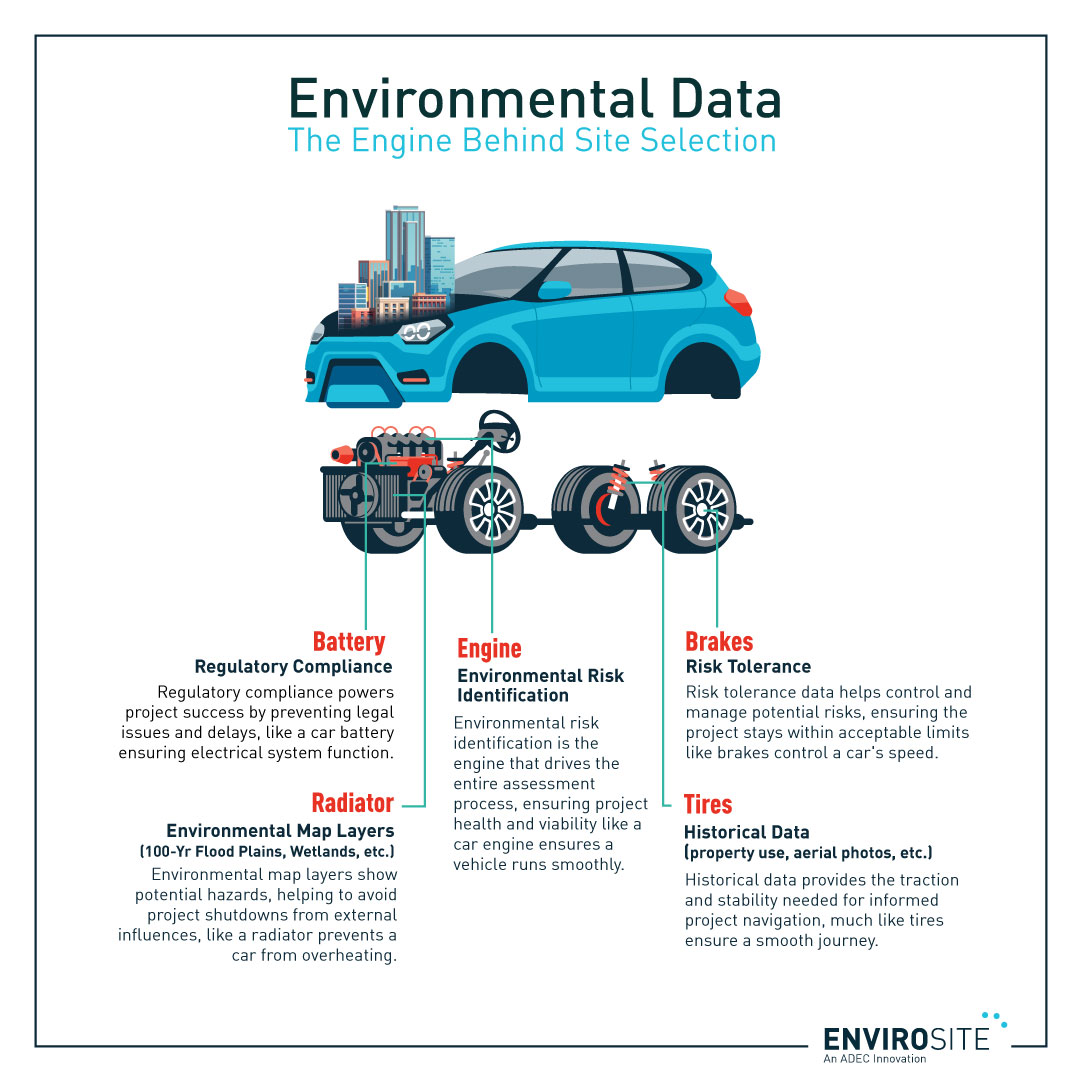Environmental Data: The Engine Behind Site Selection
Article
Site pre-project planning begins by factoring these 5 key environmental data points before determining a site and beginning a new project.

Thorough pre-project planning in commercial real estate has become indispensable, reflecting a significant shift in industry practices. Professionals now recognize that what lies beneath the surface is as, if not more, important as what is visible. Environmental screenings are an essential part of the planning process, helping to uncover potential environmental hazards like soil contamination, historical use, compliance liabilities, and more. Today, the use of advanced environmental risk assessment platforms helps make better informed decisions before identified issues become costly problems. This proactive approach ensures projects are built on a solid, sustainable and resilient foundation. This deeper understanding has changed the landscape of commercial real estate (CRE).
Think of a CRE project like purchasing a vehicle. In the past, a car’s perfect-looking exterior might have been enough to captivate a buyer, with the mechanical check coming only as an afterthought. Today, savvy car buyers know that understanding the engine’s condition is paramount before considering buying the vehicle. Similarly, CRE Professionals must prioritize environmental screenings before being swayed by a property’s surface appeal. Just as one wouldn’t purchase a car without a thorough inspection, examining “under the hood” aspects of a property project is essential.
Here are five critical areas of environmental data to check when you “look under the hood” of your property:
- Environmental Risk Identification – Engine: Environmental risk identification functions like the engine of a car, driving the entire assessment process. Identifying potential environmental risks early ensures the project’s health and viability, much like a well-maintained engine ensures a car runs smoothly.
- Regulatory Compliance – Battery: Regulatory compliance is akin to the battery of a car, providing necessary power to keep everything running. Making sure that a project complies with all environmental regulations prevents unforeseen legal issues and project delays, Like the battery ensures the car’s electrical systems function properly, so does regulatory compliance.
- Historical Data (Property Use, Aerial Photos, Fire Insurance Maps, etc.) – Tires: Historical data is comparable to the tires, providing traction and stability needed for a smooth journey. This data helps developers understand the property’s past uses and potential issues, allowing them to navigate the project with confidence and avoid pitfalls.
- Risk Tolerance Data – Brakes: Risk tolerance data acts like the brakes of a car, helping to control and manage the potential risks associated with a property. This data allows real estate and environmental professionals to understand the level of risk they are willing to accept and plan accordingly. Risk tolerance data ensures that the project does not exceed these limits.
- Environmental Map Layers (100-Yr Flood Plains, Wetlands, Superfund sites, etc.) – Radiator: Environmental map layers provide crucial information on potential hazards. Like a radiator keeps a car from overheating by regulating its temperature, map layers help developers understand the property’s susceptibility to natural disasters and contamination, ensuring a project doesn’t shut down from too many outside influences.
Incorporating thorough environmental screenings into pre-project planning for commercial real estate is more critical than ever. Professionals now understand that what lies beneath the surface can be as crucial as what’s on the surface, ensuring that projects start with a solid foundation. Navigating these key factors can be seamlessly achieved through one-stop technologies like environmental risk maps. Just as a car’s radiator, brakes, battery, tires, and engine each play a vital role in its overall performance and safety, the five critical areas of environmental assessment are integral to the sustainability and resiliency of real estate projects.
Environmental risk maps integrate these essential components into a single, user-friendly platform, allowing developers to visualize and analyze potential environmental hazards, compliance issues, and environmental map layers in one location. This holistic approach not only streamlines the assessment process but also enhances the accuracy and efficiency of risk evaluations.
By leveraging such advanced tools, professionals ensure their projects are not only “aesthetically” pleasing but also structurally sound and environmentally responsible. This comprehensive and technologically-driven strategy fosters resilience and long-term viability, much like how informed car buyers ensure their vehicles are both reliable and high-performing. Embracing these practices through a unified platform not only safeguards investments but also contributes to the creation of safer, healthier, and more sustainable communities.
Gain premium access to the property risk map and start uncovering your risk before your project starts.
No committment necessary






